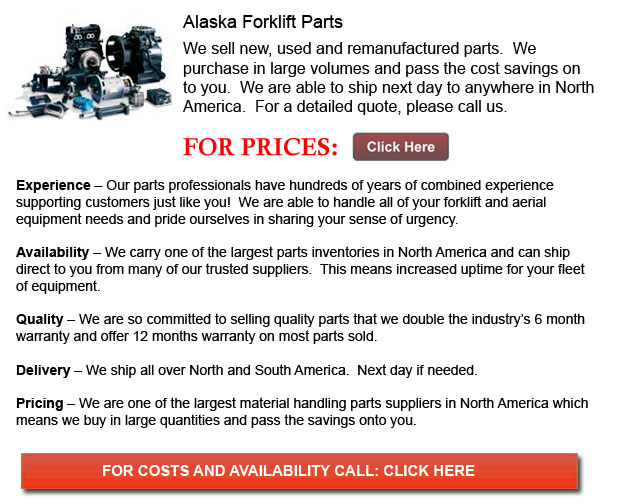
Alaska Forklift Parts - Alaska is the biggest state within the United States by area. It is located in the northwest extremity of the North American continent, with Canada to the east, the Arctic Ocean to the north, and the Pacific Ocean to the south and west, with Russia further west across the Bering Strait. Approximately half of Alaska's 710,231 people, as per the 2010 United States Census, live in the Anchorage metropolitan area. Alaska is the least densely populated state of the United States.
Alaska was purchased from the Russian Empire on the 30th of March, the year 1867, for $7.2 million ($113 million in today's dollars) at around two cents for every acre ($4.74/km2). The land went through several administrative changes before becoming an incorporated territory on May 11, the year 1912; and the 49th state of the U.S. on the 3rd of January, 1959.
"Alaska" was the name which was already given to the peninsula by the Russians during the colonial period. The name derived from the Aleut alaxsxaq, that means "the mainland" or more literally, "the object towards which the action of the sea is directed." It is also known as Alyeska, the "great land", an Aleut word which came from the same root.
The 2007 gross state product was $44.9 billion, 45th within the US. Its per capita personal income for 2007 was $40,042, ranking 15th within the country. The gas and oil industry dominates the Alaskan economy, with more than 80% of Alaska's revenues coming from from petroleum extraction. The state's main export product other than natural gas and oil is seafood, mainly salmon, cod, Pollock and crab.
Agricultural production within the state of Alaska represents only a small part of the states economy. The produce is used mostly for in-state consumption, including nursery stock, dairy products, vegetables, and livestock. Manufacturing is limited, with nearly all general goods and foodstuff imported from somewhere else.
Employment is primarily in government and industries like for example natural resource extraction, shipping, and transportation. Military bases are a substantial factor of the economy in both Anchorage and Fairbanks. Federal subsidies are likewise a vital part of the economy, allowing Alaska to be able to keep taxes low. Its industrial outputs are natural gas, crude petroleum, gold, coal, precious metals, zinc and other mining, seafood processing, wood products and timber.
The state of Alaska has large amounts of energy resources, with major reserves of gas and oil situated in both the Alaska North Slope (ANS) and Cook Inlet basins. Alaska ranks 2nd within the nation for production of crude oil, according to the Energy Information Administration. Prudhoe Bay on Alaska's North Slope is the highest yielding oil field within the US and on North America, usually producing approximately 400,000 barrels each and every day (64,000 m3/d).
The Trans-Alaska Pipeline can pump and transport up to 2.1 million barrels (330,000 m3) of crude oil each day, more than any other crude oil pipeline within the nation. Furthermore, substantial coal deposits are located in Alaska's sub-bituminous, bituminous, and lignite coal basins. Alaska likewise provides some of the highest hydroelectric power potential in the country from its various rivers. Large swaths of the Alaskan shoreline provide wind and geothermal energy potential too.
Lift Parts Express
TOLL FREE: 1-888-695-7994
forkliftpartsalaska.com
Email Us
About Us

